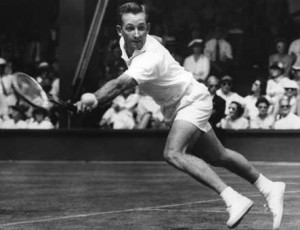A heavyweight championship of tennis? That’s how a 1975 match-up between Rod Laver Jimmy Connors was billed in 1975 in Las Vegas. Here’s how Laver described the much-hyped match in his newly updated memoir THE EDUCATION OF A TENNIS PLAYER ($19.95, New Chapter Press).
Written with Hall of Fame journalist and historian Bud Collins, THE EDUCATION OF A TENNIS PLAYER is Laver’s first-hand account of his famous 1969 Grand Slam season, capped off by his win over fellow Australian Tony Roche in the final of the U.S. Open. Laver also writes about his childhood and early days in tennis, his 1962 Grand Slam and offers tips on how players of all levels can improve their game. He also shares some of the strategies that helped him to unparalleled success on the tennis court.
Originally published in 1971, the memoir was updated by Laver and Collins with new content including his recovery from a near-fatal stroke in 1998 and helping Australia once again win the Davis Cup in 1973. The memoir features descriptions of Laver’s most suspenseful matches and memorable portraits of his biggest rivals Ken Rosewall, Lew Hoad, Tony Roche and Pancho Gonzalez.
ALMOST “HEAVYWEIGHT CHAMPION”
After Jimmy Connors won his first U.S. title in 1974 at Forest Hills, he shouted, “Get me Laver!”
Maybe. Maybe not. But that’s what his shrewd manager, Bill Riordan, reported, and who wants to spoil a good story with the facts? He and Jimmy, who was No. 1, wanted a showdown with me to decide what Riordan baptized as the “Heavyweight Championship of Tennis.” It caught on.

Riordan, a clever promoter of the U.S. indoor circuit that opposed Lamar Hunt’s WCT, had grown up as a boxing fan. His father had managed a few fighters, and Bill was adept with the ballyhoo to sell a bout. He got CBS and Caesar’s Palace in Las Vegas behind it as the site Feb. 2, 1975. The publicity was terrific.
Why not? One generation’s champion clashing with another’s. Of course neither Jimmy nor I qualified as heavyweights in a boxing sense (175 pounds or over), but we trained hard. I was all for it because the pay day was the best I’d seen for punching a tennis ball — $60,000 as my end. Connors got $100,000. A lot of money then. CBS would get into trouble later for billing the so-called prize money as “Winner take all!” But, like prizefighters, we came to terms – Riordan and my agents negotiating — beforehand. The title, heavyweight champion, sounded great, but had no real meaning. Jimmy and I wouldn’t have traded our Wimbledon titles for it. All it meant was that a 22-year-old could beat a 36-year-old.
And he did, 6-4, 6-2, 3-6, 7-5. But it was fun to test myself against the current strongboy. I felt I played well, made him work for it. The crowd was with me, and that displeased Jimmy, who raised the well-known finger to toward one sector.
But he was in the early unpopular phase of his career that blossomed when the U.S. Open moved to Flushing Meadow in 1978. His competitive zeal made him deservedly an all-time favorite. When he, a 10-to-1 favorite, lost his Wimbledonchampionship to Arthur Ashe in 1975, I must admit I was pleased because Arthur was really fulfilling his promise. Riordan kept the “Heavyweight Championship” going against John Newcombe, Ilie Nastase and Spaniard Manolo Orantes. Jimmy knocked us all out, but the concept had seen its day. Revelations that the “winner take all” pitch was phony tarnished the idea. Jimmy and Riordan parted.
Later in the year, I again dipped into the new generation in matches with the surging Swedish teenager Bjorn Borg. He was obviously going places, but I wasn’t unhappy with my losses to him. It took him five long sets to beat me in the WCT semis at Dallas, and four to knock me out of the fourth round of the U.S. Open. Forest Hills had torn up the grass courts of my 1962 and 1969 titles to lay green clay, and also installed floodlights. Since 1978, Flushing Meadow has been paved with hard courts, and their color is now blue.
Wooden rackets were becoming extinct, and many manufacturers of metal clubs were popping up. One of them, short lived, was Chemold aluminum that I endorsed, and you could buy for $15. Imagine that. But I did win the Italian Open with one in 1971.
In 1990, the ATP killed the WCT circuit and playoffs, and now controls the men’s tour other than the majors. It was an unkind, ungrateful act to drop Lamar Hunt from tennis, the man to whom so much was owed. Lamar, who died in 2006 and is in the International Tennis Hall of Fame, led the professionalization of the men’s game.
From 1976 to 1978, I played World Team Tennis for the San Diego Friars. At age 38 in 1976, I even earned WTT “Rookie of the Year” honors. With such teammates as Cliff Drysdale, Ross Case, Terry Holladay, Kerry and Raz Reid, the team was high on camaraderie. It was most enjoyable. My last official pro match was on April 24, 1979 when I lost to countryman John Alexander 6-7, 6-3, 6-1 in the first round of the Alan King Classic at Caesar’s Palace in Las Vegas.
